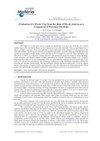不同测量方法对义齿印模材料尺寸变化的影响
IF 1.2
4区 材料科学
Q4 MATERIALS SCIENCE, MULTIDISCIPLINARY
引用次数: 2
摘要
本研究的目的是验证替代技术的有效性,以测量由不同压模材料获得的模具的线性尺寸变化。一个包含三条线的不锈钢模具被用来得到印模。压模材料是按照制造商的说明处理的。凝胶/聚合时间后,模具(n=12)保存30分钟,随后使用显微镜(奥林巴斯测量显微镜STM;奥林巴斯光学公司(Olympus Optical Co)配有30倍放大镜(MM,对照组),数字卡尺(Mitutoyo Digimatic;川崎)(DC)和使用数码相机(佳能EOS Rebel 3Ti;佳能)(DI)。对于每个模具,得到了线条长度的平均值。对于每种压模材料,金属基体和模具之间的长度差异被认为是线性尺寸变化(%)。资料采用非参数Kolmogorov-Smirnov检验,各资料采用单因素方差分析(ANOVA),均数比较采用Tukey检验(α=0.05)。除腻子体冷凝硅胶外,DI组的尺寸精度值与对照组(MM)无显著差异。DC组和DI组在所有测试的印模材料上均有显著差异。DI组显示出一种可靠的方法(平均标准误差<10%)来测量所有印模材料的线性尺寸变化。除腻子体添加硅胶外,DI组的模具线性尺寸变化值与MM组无显著差异。除了腻子体弹性体压模材料外,数字化是评估用压模材料制成的模具线性尺寸变化的可靠方法。关键词:尺寸测量精度;牙印模材料;显微镜本文章由计算机程序翻译,如有差异,请以英文原文为准。
Dimensional change of impression materials for dental prothesis using different measuring methods
The aim of this study was to verify the effectiveness of alternative techniques for measuring the linear dimensional change of molds obtained by different impression materials. A stainless-steel die containing three lines was used to get the impressions. The impression materials were handled according to the manufacturers' instructions. After gelation/polymerization time, the molds (n=12) were stored for 30 minutes and the lines were subsequently measured using: a microscope (Olympus Measuring Microscope STM; Olympus Optical Co) with a 30x magnification (MM, control group), a digital caliper (Mitutoyo Digimatic; Kawasaki) (DC) and digitization using a digital camera (Canon EOS Rebel 3Ti; Canon) (DI). For each mold, a mean of the length of the lines was obtained. For each impression material, the difference in the length between the metallic matrix and the mold was considered as linear dimensional change (%). The data were submitted to the non-parametric Kolmogorov-Smirnov test, followed by one-way Analysis of Variance (ANOVA) for each material, and the means were compared by the Tukey test (α=0.05). The DI group promoted values of dimensional accuracy without significant differences with the control group (MM), except for the putty-body condensation silicone. The DC group showed significant differences for MM and DI groups for all impression materials tested. The DI group showed to be a reliable methodology (Standard error of the mean <10%) to measure the linear dimensional change of all impression materials. The DI group presented molds with linear dimensional change values without significant differences with MM group, except for the putty-body addition silicone. The digitization is a reliable methodology to evaluate the linear dimensional changes of molds made with impression materials, except for the putty-body elastomeric impression materials. Key words: Dimensional Measurement Accuracy; Dental impression materials; Microscopy
求助全文
通过发布文献求助,成功后即可免费获取论文全文。
去求助
来源期刊

Materia-rio De Janeiro
MATERIALS SCIENCE, MULTIDISCIPLINARY-
CiteScore
1.00
自引率
25.00%
发文量
51
审稿时长
6 weeks
期刊介绍:
All the articles are submitted to a careful peer-reviewing evaluation process by the journal''s Editorial Board. The Editorial Board, reviewers and authors make use of a web based proprietary automated tool to deal with the reviewing procedures.the Revista Matéria''s article reviewing restricted access system - SEER. Authors are not informed about the identity of the reviewers.
 求助内容:
求助内容: 应助结果提醒方式:
应助结果提醒方式:


